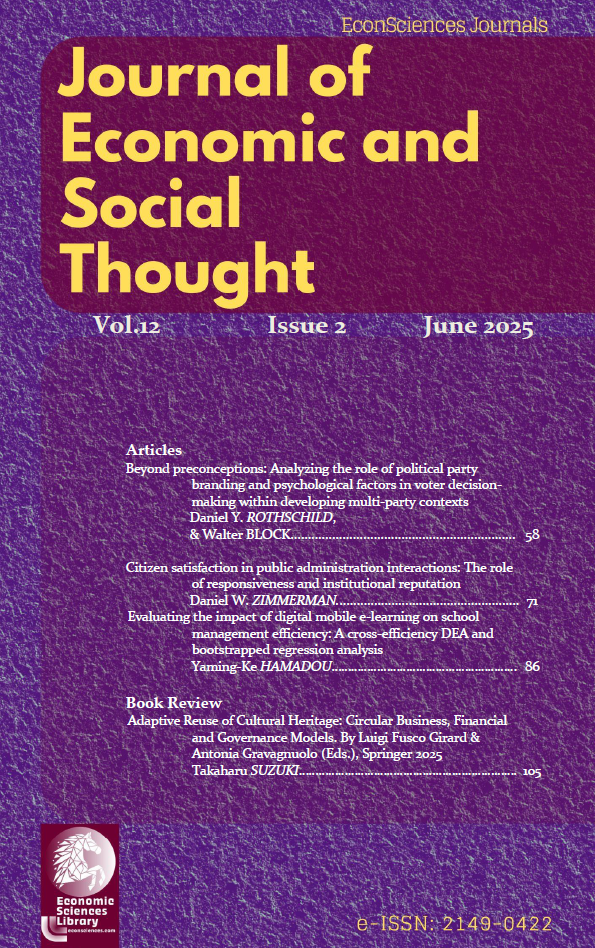Abstract
Conventional Data Envelopment Analysis (DEA) models often fail to capture the necessary cooperation between Decision-Making Units (DMUs), which can lead to inaccuracies in efficiency evaluations. To address this limitation, this paper utilizes a cross-efficiency approach combined with a Bootstrap Truncated Regression (BTR) model to investigate the specific effect of digital mobile e-learning implementation on the overall efficiency of school operations. The empirical findings yield several key results: The adoption of digital mobile e-learning significantly improves school management efficiency. Factors such as school scale, the number of tablet PCs, total expenditure on tablet-related equipment, and geographic location are identified as critical determinants of administrative efficiency. The government's push for the new learning model aims to provide students with a genuine experience of modern education and thereby boost enrollment. In line with this, the study recommends that to maximize the schools' cross-efficiency, upgrading Wi-Fi technology and network infrastructure is essential. Enhancing the network capacity will attract more institutions to adopt the new pedagogical approach and, consequently, facilitate an increase in school size. Conversely, a crucial finding is the negative influence of the total equipment expenses associated with tablet PCs on school management efficiency. This is primarily attributed to the increased burden of costs incurred for procuring and setting up the necessary internet and network devices required to support digital mobile e-learning for both teachers and students. The outcomes of this research offer valuable guidance for Taiwan’s educational authorities as they develop policies and regulations aimed at scaling up digital mobile e-learning across high schools.
Keywords. Digital Mobile E-Learning; School Efficiency; Data Envelopment Analysis (DEA); Cross-Efficiency; Bootstrap Truncated Regression (BTR).
JEL. I21; D24; C14; C24; H52.
References
Banker, R. D., Charnes, A., & Cooper, W. W. (1984). Some models for the estimation of technical and scale inefficiencies in data envelopment analysis. Management Science, 30(9), 1078–1092. https://doi.org/10.1287/mnsc.30.9.1078
Badri, M. A., & Mourad, T. (2012, April). Determinants of school efficiencies in Abu Dhabi using DEA. In International Conference on Management and Education Innovation (IPEDR, Vol. 37). [Conference paper].
Çelen, A. (2013). Efficiency and productivity (TFP) of the Turkish electricity distribution companies: An application of two-stage analysis. Energy Policy, 63, 300–310. https://doi.org/10.1016/j.enpol.2013.09.034
Charnes, A., Cooper, W. W., Lewin, A. Y., & Seiford, L. M. (1994). Introduction. In A. Charnes, W. W. Cooper, A. Y. Lewin, & L. M. Seiford (Eds.), Data Envelopment Analysis: Theory, Methodology, and Applications (pp. 3–21). Springer Netherlands. https://doi.org/10.1007/978-94-011-0353-5_1
Charnes, A., Cooper, W. W., & Rhodes, E. (1978). Measuring the efficiency of decision making units. European Journal of Operational Research, 2(6), 429–444. https://doi.org/10.1016/0377-2217(78)90138-8
Crescente, M. L., & Lee, D. (2011). Critical issues of m-learning: Design models, adoption processes, and future trends. Journal of the Chinese Institute of Industrial Engineers, 28(2), 111–123. https://doi.org/10.1080/10170669.2010.548856
Chen, W., Zhou, K., & Yang, S. (2017). Evaluation of China’s electric energy efficiency under environmental constraints: A DEA cross efficiency model based on game relationship. Journal of Cleaner Production, 164, 38–44. https://doi.org/10.1016/j.jclepro.2017.06.178
Dawabi, P., Wessner, M., & Neuhold, E. (2004). Using mobile devices for the classroom of the future. In J. Attawell & C. Savill-Smith (Eds.), Learning with Mobile Devices: Research and Development (pp. 55–59).
Du, J., Cook, W. D., Liang, L., & Zhu, J. (2014). Fixed cost and resource allocation based on DEA cross-efficiency. European Journal of Operational Research, 235(1), 206–214. https://doi.org/10.1016/j.ejor.2013.10.002
Doyle, J., & Green, R. (1994). Efficiency and cross-efficiency in DEA: Derivations, meanings and the uses. Journal of the Operational Research Society, 45(5), 567–578. https://doi.org/10.1057/jors.1994.84
Falagario, M., Sciancalepore, F., Costantino, N., & Pietroforte, R. (2012). Using a DEA-cross efficiency approach in public procurement tenders. European Journal of Operational Research, 218(2), 523–529. https://doi.org/10.1016/j.ejor.2011.10.031
Farrar, D. E., & Glauber, R. R. (1967). Multicollinearity in regression analysis: The problem revisited. The Journal of Econometrics and Statistics, 49(1), 92–107. https://doi.org/10.2307/1937887
Goh, T., & Kinshuk, D. (2006). Getting ready for mobile learning—adaptation perspective. Journal of Educational Multimedia and Hypermedia, 15(2), 175–198.
Hausman, J. (1978). Specification tests in econometrics. Econometrica, 46(6), 1251–1271. https://doi.org/10.2307/1913827
Kumbhakar, S. C., & Lovell, C. A. K. (2000). Stochastic Frontier Analysis. Cambridge University Press.
Milrad, M., Hoppe, U., Gottdenker, J., & Jansen, M. (2004). Exploring the use of mobile devices to facilitate educational interoperability around digitally enhanced experiments. In Wireless and Mobile Technologies in Education, 2004. Proceedings. The 2nd IEEE International Workshop on (pp. 182–186). IEEE.
Ozdamli, F., & Cavus, N. (2011). Basic elements and characteristics of mobile learning. Procedia – Social and Behavioral Sciences, 28, 937–942. https://doi.org/10.1016/j.sbspro.2011.11.173
O’Malley, C., Vavoula, G., Glew, J. P., Taylor, J., Sharples, M., Lefrere, P., … & Waycott, J. (2005). Guidelines for learning/teaching/tutoring in a mobile environment. [Paper].
Oral, M., Amin, G. R., & Oukil, A. (2015). Cross-efficiency in DEA: A maximum resonated appreciative model. Measurement, 63, 159–167. https://doi.org/10.1016/j.measurement.2014.12.006
Sexton, T. R., Silkman, R. H., & Hogan, A. J. (1986). Data envelopment analysis: Critique and extensions. In R. H. Silk (Ed.), Measuring Efficiency: An Assessment of Data Envelopment Analysis (Vol. 32, pp. 73–105). Jossey-Bass.
Sexton, T. R., Leiken, A. M., Sleeper, S., & Coburn, A. F. (1989). The impact of prospective reimbursement on nursing home efficiency. Medical Care, 154–163.
Simar, L., & Wilson, P. (2007). Estimation and inference in two-stage, semi-parametric models of production processes. Journal of Econometrics, 136(1), 31–64. https://doi.org/10.1016/j.jeconom.2005.07.009
Singh, M. (2010). M-Learning: A new approach to learn better. International Journal of Education and Allied Sciences, 2(2), 65–72.
Tobin, J. (1958). Estimation of relationships for limited dependent variables. Econometrica: Journal of the Econometric Society, 26(1), 24–36. https://doi.org/10.2307/1907382
Wang, Y. S., Wu, M. C., & Wang, H. Y. (2009). Investigating the determinants and age and gender differences in the acceptance of mobile learning. British Journal of Educational Technology, 40(1), 92–118. https://doi.org/10.1111/j.1467-8535.2007.00809.x
Wu, J., Sun, J., & Liang, L. (2012). Cross-efficiency evaluation method based on weight-balanced data envelopment analysis model. Computers & Industrial Engineering, 63(2), 513–519. https://doi.org/10.1016/j.cie.2012.04.017
Wu, J., Chu, J., Sun, J., Zhu, Q., & Liang, L. (2016b). Extended secondary goal models for weights selection in DEA cross-efficiency evaluation. Computers & Industrial Engineering, 93, 143–151. https://doi.org/10.1016/j.cie.2015.12.019

This work is licensed under a Creative Commons Attribution-NonCommercial 4.0 International License.
